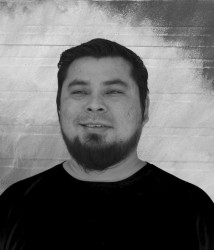Article Origin
Volume
Issue
Year
Born artist gave all he had
While other kids in Wikwemikong, on Ontario’s Manitoulin Island, were running around with baseball bats and jars for catching frogs, Josh Peltier carried paint brushes or a sketchpad.
Surrounded and inspired by great Woodland Anishnaabe artists like Leland Bell and Daphne Odjig, Josh continued creating until he realized he needed to expand his horizon.
At 16, he left home for Toronto, where he enrolled in high school and got a part-time job selling coffee and soft drinks from a cart in a bingo hall. After completing school, he applied to OCAD (Ontario College of Art and Design) and graduated from the Sculpture and Installation Program, but painting, especially murals, remained his passion.
After living in the city for 11 years, Josh moved back to Wikwemikong in 2004 to take care of his daughter Caleja from a past relationship.He had worked for the Debajehmujig Creation Centre in Manitowaning before, but with his new credentials he was offered a job in 2008 to head the visual arts department. He also curated the centre’s gallery and wrote and directed theatre productions.
“I came to Debaj and found out that I got to teach the way I wanted to teach,” he said in a quote in the Manitoulin Expositor. “There are so many different things I can teach here and if I don’t know how to do something I figure it out. As an artist I always find new ways to learn and create.”
He lauded the Debajehmujig Creation Centre as a “one of a kind facility that opens you up to so many possibilities.”
Joe Osawabine, Debajehmujig’s artistic director, said Josh had unending commitment and passion for his community. “When he got back home he kept painting on canvas. Airbrushing acrylics was his specialty. Everywhere you go you can see his work. It’s in the Wikwemikong band office and other places.
“When Josh worked on an installation called the League of Cultural Emancipators, he had everyone in Debajehmujig take part. He made portraits of about 20 or so people in the community who were recognized as having revitalized the Anishnaabe culture in the 50’s and 60’s. He outlined each portrait like a paint-by-numbers painting and had the members come in and do the broad strokes. He’d come in behind and do the detailing. He made it into a beautiful community project. It wasn’t just him doing it all. He loved to have others share in creativity. He was always making murals with the youth.”
In the summer of 2006, while working on Biidaasigekwe (Sunlight Woman), a play in the Anishnaabe language, Josh met Jessica Wilde, a young performer from Kettle and Stony Point First Nation near Sarnia, Ontario. He was smitten and, after working with her for only a month, asked her to marry him.
“I wasn’t ready for marriage, but when he proposed, I said ‘yes’,” recalled Wilde-Peltier. “I’d always dreamed of being with an artist who had his own style. I wanted a smart guy, a funny guy. I couldn’t believe it when I had the whole package.”
Wilde-Peltier’s mother consented to the marriage as long as Josh promised to bring her home whenever she wanted. “True to his word, if I was getting kind of homesick he’d just say ‘all right, I’ll start packing the van’ and away we’d go,” Wilde-Peltier said.
“He was a true romantic. When we visited Scotland as part of the Global Savages, he hired a bagpipe player to play for my birthday and then took me to Ireland. We worked, travelled, hung out together and had the same friends. We were together 24 hours a day.”
The Global Savages, conceptualized by Osawabine and Ron Berti, Debajehmujig producer, is a travelling entourage of performers who share Anishnaabe history, culture and traditions with Canadian and international audiences.
“We told people about our oral history as we learned it from our Elders – like the concept of Turtle Island, stories of the thunderbird and underwater serpents, the imbalance of the world and the preservation of humanity,” explained Osawabine. “Josh was so proud to represent the Anishnaabek nation out there in the world. He was always an ambassador for his community, his family, and for our nation as a whole.
After performing in the 2014 On Common Ground outdoor event in Glasgow, Scotland, Josh blogged that, as a kid, he didn’t think that being an artist would take him anywhere but “I was born an artist and I won’t and can’t be anything else. I’ve only ever known how to be an artist. Even though we’ve never had a word for art, I’ve worked my whole life, so far, as an artist and now I get the chance to share that with the world.”
Josh was born on Dec. 6, 1976 to parents Alex (Nixon), and Genevieve (Zhunyip) Peltier. Though his parents parted ways some years ago, the family continued to get together regularly in the house Josh grew up in.
“His parents even brought their new partners to the gatherings and everyone still hung out. It was cool that way,” said Osawabine.
When Alex passed away a year ago, Josh replaced his father as the family patriarch and encouraged the family to continue regular get-togethers.
Before his death, Josh was working hard to reclaim his culture and was trying to find the courage to play the drum. A year and a half ago he began to create ephemeral art that eventually returned to the earth over time.
“He’d create something with animal hide pieces and just watch it over the months to see how the earth reacted to it. Or he’d work on canvas using natural materials like beehive comb, wood and feathers. He was finding new ways to take his art back to nature, the place where he came from,” said Wilde-Peltier.
Josh passed away on April 20, 2015 from complications of liver and kidney damage. He was 39 years old.
- 8694 views

